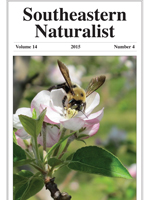For amphibian species suspected of undergoing enigmatic declines, it is important to determine the effort required to confidently establish species absence. Desmognathus auriculatus (Southern Dusky Salamander) has purportedly gone from being quite common throughout the southeastern US Coastal Plain to now being enigmatically rare. We used repeated standardized surveys of 5 historically occupied streams and their adjacent riparian zones between 2007 and 2010 to estimate detection rate of Southern Dusky Salamanders. We detected Southern Dusky Salamanders at 3 of 5 historic sites. Mean detection rate across streams known to be occupied at least once during the study was moderately low (mean ± 1 SE = 0.20 ± 0.12 for a double-sampled 50-m survey), improved at 2 sites with increasing time since drought, and varied among streams. For comparison, we evaluated detection rates of several other stream salamanders and found those rates to range from 0.37 (± 0.07) for Eurycea quadridigitata (Dwarf Salamander) to 0.08 (± 0.01) for Siren intermedia (Lesser Siren). Based on mark—recapture along a 200-m section of stream and the associated riparian habitat at the site where Southern Dusky Salamanders were most often detected, we estimated 43 (± 15) and 97 (± 161) individuals to be present February—May 2009 and October 2009–May 2010, respectively. Despite abundant adults, Southern Dusky Salamanders were the only species that we failed to detect as larvae; however, we observed many newly metamorphosed Southern Dusky Salamanders–usually under logs with saturated soil and often near entrances to crayfish burrows. Our results generally support the characterizations of Southern Dusky Salamanders as having become enigmatically uncommon. Because landcover change in the study area has been minimal, we suspect habitat damage from Sus scrofa (Feral Pig) may be responsible for the variation in Southern Dusky Salamander presence and abundance among sites. Because of the low detectability of Southern Dusky Salamanders, future work to identify factors driving Southern Dusky Salamander distribution and abundance will require intensive sampling at sites to provide robust estimates of occupancy or population size.
How to translate text using browser tools
1 December 2015
Detecting Enigmatic Declines of a Once Common Salamander in the Coastal Plain of Georgia
John C. Maerz,
R. Kyle Barrett,
Kristen K. Cecala,
Jayna L. Devore
ACCESS THE FULL ARTICLE
<
Previous Article
|

Southeastern Naturalist
Vol. 14 • No. 4
December 2015
Vol. 14 • No. 4
December 2015




